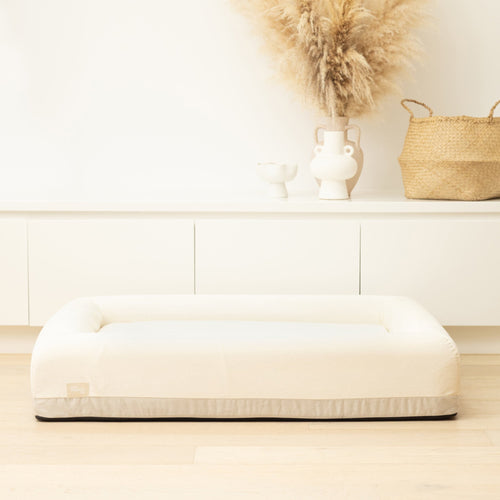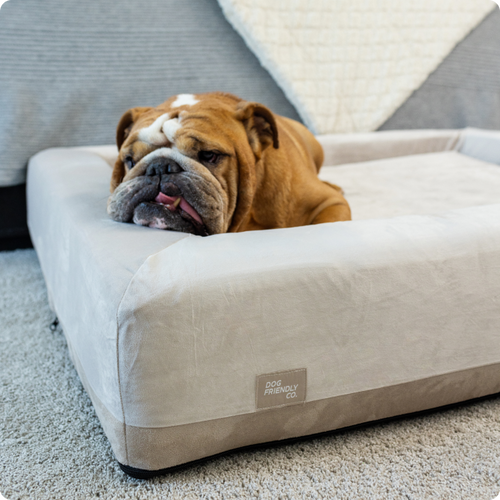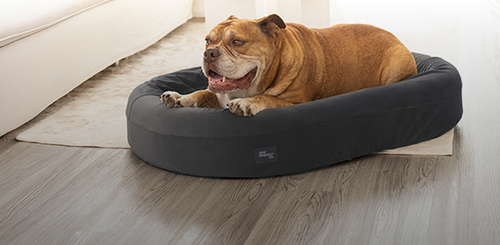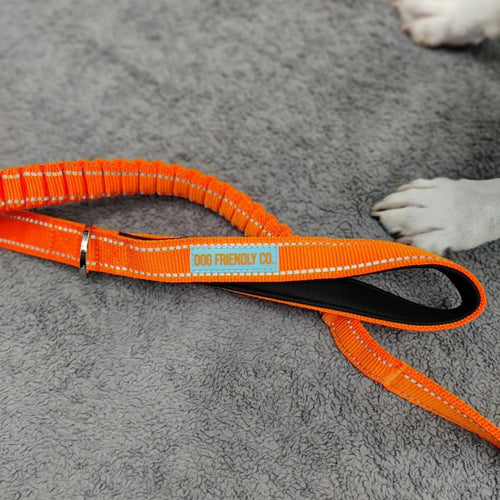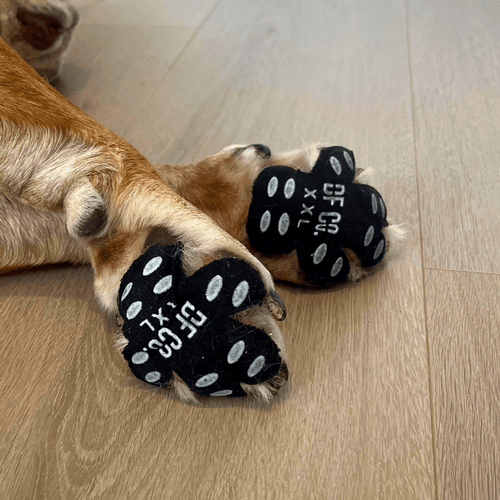If you've ever caught your dog scratching at your bed sheets, you’re not alone. Many pet owners notice this seemingly odd behaviour, and while it can be a bit frustrating, there’s often an understandable reason behind it. In this article, we’ll explore why dogs scratch bed sheets and how you can address this behaviour with simple, practical solutions.
Understanding the Behavior
Scratching is a natural behaviour for dogs, passed down from their wild ancestors. While it can sometimes seem destructive, it’s often tied to instinctual or emotional needs.
Natural Instincts
Your dog’s tendency to scratch likely stems from behaviours inherited from wild dogs. In the wild, dogs would dig and scratch at the ground to create a comfortable nest for sleeping. This nesting instinct is why your dog may scratch at your bed sheets—it’s their way of preparing their “den” to make it cosy and secure.
Behavioural Context
While scratching can be normal, it’s important to understand the underlying cause. Sometimes it’s a sign of deeper issues, like anxiety or discomfort. By identifying the root cause, you can address the behaviour more effectively and prevent unnecessary damage to your bedding.
Common Reasons for Scratching Bed Sheets
There are several reasons why dogs scratch bed sheets. Whether it’s instinctual or a response to discomfort, understanding these factors is key to solving the issue.
Instinctual Behavior
- Nesting Instincts: Just as wild dogs prepare their sleeping areas, your dog may be scratching to create a comfortable spot. This behaviour is rooted in their survival instincts, where they would dig and arrange their bedding to keep themselves safe and warm.
- Marking Territory: Dogs have scent glands in their paws, and scratching can be a way for them to mark their territory. When your dog scratches the bed, they might be leaving their scent behind as a way of claiming their space.
Comfort-Seeking Behaviour
- Temperature Regulation: Scratching can help dogs adjust their sleeping area by exposing cooler surfaces underneath or fluffing up blankets. This behaviour helps them regulate their body temperature, especially during warmer months.
- Searching for Comfort: Dogs may scratch to make their bedding feel more comfortable. By rearranging sheets or blankets, they’re essentially trying to create a sleeping surface that suits their preferences.
Anxiety or Stress
- Separation Anxiety: Dogs that experience separation anxiety may scratch bedding as a way to soothe themselves when they’re feeling anxious, particularly when left alone.
- Changes in Environment: Moving to a new home or changes in the household (such as new pets or family members) can stress dogs, leading them to scratch bedding as a coping mechanism.
Attention-Seeking Behaviour
- Seeking Interaction: If your dog notices that scratching gets a reaction from you, they may repeat the behaviour to gain your attention. This can become a learned behaviour, especially if they’re feeling ignored or under-stimulated.
- Boredom: Dogs need regular mental and physical stimulation. Without it, they may resort to scratching as a way to burn off excess energy or entertain themselves.
Medical Issues
- Skin Irritation or Allergies: If your dog has itchy skin due to allergies, fleas, or other irritants, they may scratch more frequently, including on your bed.
- Arthritis or Joint Pain: Older dogs suffering from joint pain or arthritis may scratch the bed in an attempt to find a comfortable position, as they may have difficulty settling down due to discomfort.
Habitual Behaviour
- Learned Behaviour: Over time, dogs can develop a habit of scratching bed sheets even without an obvious cause. This habitual scratching may continue if it has been reinforced by past behaviours or responses from the owner.
- Reinforcement: If your dog has received attention or rewards (even unintentionally) for scratching the bed, they may view it as a way to get what they want, reinforcing the habit.
Specific Considerations for Different Dog Breeds
Some breeds are more prone to scratching due to their natural instincts or behaviours.
Breeds with Strong Instincts
- Terriers and Digging: Terriers, known for their strong digging instincts, are more likely to scratch and dig at bed sheets. This behaviour is hardwired into their DNA, making it a common occurrence in these breeds.
- Herding Breeds: Herding dogs, like Border Collies and Australian Shepherds, often scratch as part of their instinctual drive to control their environment, whether that’s herding animals or “arranging” their sleeping area.
Small vs. Large Breeds
- Size-Related Comfort: Smaller breeds may scratch more often to feel secure, especially when they’re nesting in large, open spaces like a bed. Larger breeds, on the other hand, might scratch to rearrange bedding for comfort and support.
How to Address and Prevent the Behaviour
If your dog’s scratching is becoming an issue, there are several strategies you can implement to reduce or prevent it.
Provide a Comfortable Sleeping Area
- Dog-Specific Bedding: Offer your dog a comfortable, dedicated bed that meets their needs. A supportive, cosy dog bed can reduce their desire to scratch your bed sheets.
- Temperature Control: Ensure your dog’s sleeping area is at a comfortable temperature. If they’re scratching to regulate heat, a cooler spot may help reduce the behaviour.
Behavioural Training
- Positive Reinforcement: Reward your dog for settling down without scratching. Positive reinforcement can help redirect their behaviour and encourage good habits.
- Set Boundaries: If your dog’s scratching persists, consider setting boundaries by keeping them off your bed. Use commands or baby gates to create clear rules about where they can sleep.
- Training Alternatives: Redirect your dog’s energy by training them to scratch in appropriate places, such as a designated digging spot or on a specific blanket.
Managing Anxiety or Stress
- Routine and Consistency: A consistent daily routine can help reduce anxiety-related scratching. Keeping your dog’s environment predictable and secure can go a long way in preventing stress-based behaviours.
- Calming Aids: Consider using calming aids, such as pheromone diffusers, calming chews, or anxiety wraps, to help your dog feel more relaxed and reduce scratching.
Medical Interventions
- Vet Consultation: If you suspect that your dog’s scratching is due to a medical issue, such as skin irritation or joint pain, consult your veterinarian. They can diagnose the underlying issue and recommend treatments to alleviate discomfort.
- Treating Underlying Conditions: For dogs with skin allergies or arthritis, addressing the root cause will help prevent the scratching behaviour. Treatments such as allergy medications, flea prevention, or joint supplements can make a big difference.
Mental and Physical Stimulation
- Exercise and Playtime: Regular exercise and mental stimulation are key to preventing boredom-related behaviours. Ensure your dog gets enough physical activity and play to keep them engaged and content.
- Interactive Toys: Providing interactive toys or puzzles can keep your dog mentally stimulated and reduce the likelihood of scratching out of boredom.
When to Seek Professional Help
If your dog continues to scratch your bed sheets despite your efforts to address the behaviour, it might be time to consult a professional dog trainer or behaviourist. These experts can conduct a thorough assessment of your dog’s behaviour, environment, and any possible triggers to develop a tailored plan that suits your dog’s needs. A behaviourist can help identify underlying emotional or behavioural issues, such as anxiety, that might be causing the scratching.
For dogs with severe anxiety, a professional can recommend desensitisation techniques, behavioural modification, or calming exercises to ease their stress. In some cases, professional trainers may work alongside your veterinarian to incorporate calming aids or medications to alleviate severe anxiety. This multi-faceted approach ensures your dog is getting the right kind of support for both their emotional and physical well-being.
If the scratching is caused by medical conditions like joint pain, arthritis, or skin irritations, your veterinarian will be an essential part of the solution. A professional trainer or behaviourist can work in conjunction with your vet to manage the behavioural side of the issue while the underlying medical condition is being treated. In severe cases, addressing both the behavioural and medical aspects simultaneously is often the most effective way to resolve the issue.
Transitioning Your Dog to an Orthopaedic Dog Bed
Helping your dog transition to an orthopaedic dog bed is simple with a few key steps. Start by placing the bed in a familiar, quiet area where your dog feels comfortable. Encourage them to explore the new bed by adding their favourite toys or a blanket. Use positive reinforcement, such as treats or praise, when they use the bed. Gradually reduce access to your furniture to reinforce the use of their new bed. The supportive, pressure-relieving design of an orthopaedic bed can enhance your dog’s comfort and overall well-being.
Ready To Take The Next Steps?
Scratching bed sheets is a fairly common behaviour in dogs, but it can be managed with patience, understanding, and the right strategies. By identifying the cause—whether it’s instinctual, comfort-seeking, anxiety-related, or medical—you can take appropriate steps to reduce or eliminate the behaviour. Providing a comfortable sleeping area, implementing consistent training, and addressing any medical or anxiety-related concerns are key to helping your dog feel more at ease.
Remember, you don’t have to tackle this issue alone. If the scratching continues or escalates, consulting a professional trainer or veterinarian can provide invaluable guidance. With the right approach, you and your dog can overcome this behaviour and enjoy a peaceful, scratch-free environment.



























